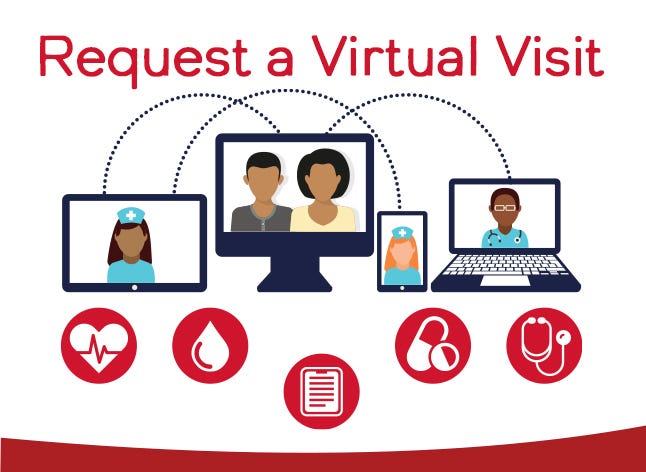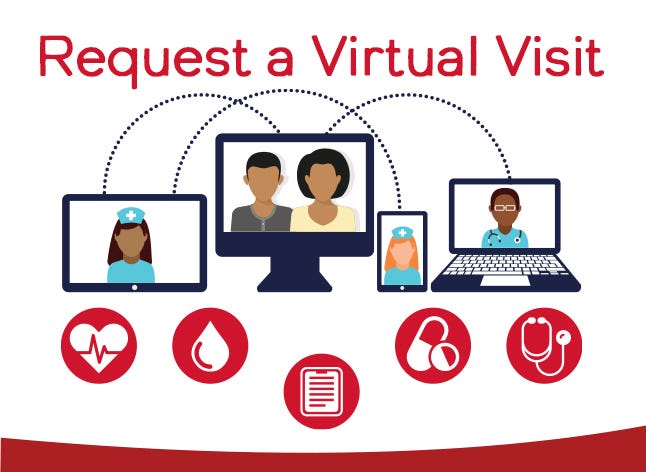Beckers Payer
Jakob Emerson
June 8, 2022
Key messages
by Joaquim Cardoso MSc.
Health and Care Strategy — Research Institute
June 8, 2022
- The first virtual-first plan in Michigan for large employers is being launched July 1 by Priority Health, a Grand Rapids-based nonprofit payer
- The payer designed the new product to compete with traditional health plans, the focus was on ease of access, cost effectiveness and quality of care.
- The plan will include tiered benefits that incentivize 24/7 virtual care at no cost through a team composed of a primary care physician, therapist, registered nurse and medical assistants.
- Priority’s new plan isn’t virtual-only, it’s a virtual-first plan integrated with traditional in-person care.
- However, some are skeptical of whether virtual-first health plans can exist outside of individual markets.

Much of the world has changed because of the COVID-19 pandemic, and that includes the emergence of virtual-first health plans, or insurance policies that prioritize telehealth for enrolled members.
The first virtual-first plan in Michigan for large employers is being launched July 1 by Priority Health, a Grand Rapids-based nonprofit payer.
“There’s this current model of care where members are lacking a strong relationship with their primary care and limited accessibility, which we see both nationally and here in Michigan, and there’s been a lack of a personalized outreach approach for virtual care,” Megan Schmidt, senior vice president of employer solutions at Priority Health, told Becker’s.
“Anytime there’s that unmet need in the market, we want to be the first to help fill it and do that in a really thoughtful way.”
Ms. Schmidt said that when the payer was designing the new product to compete with traditional health plans, the focus was on ease of access, cost effectiveness and quality of care.
The plan will include tiered benefits that incentivize 24/7 virtual care at no cost through a team composed of a primary care physician, therapist, registered nurse and medical assistants.
The plan will include tiered benefits that incentivize 24/7 virtual care at no cost through a team composed of a primary care physician, therapist, registered nurse and medical assistants.
Priority’s ideal customer for this type of plan is an employer that wants to save on benefits costs and allow their employees to choose care that fits their needs, especially in the era of remote work.
But what happens when a patient inevitably needs to visit their dentist or undergo a surgery?
As Ms. Schmidt explains it, Priority’s new plan isn’t virtual-only, it’s a virtual-first plan integrated with traditional in-person care.
“I would call it the best of both worlds,” she said. “You’re going to access through that virtual front door and then it’s going to wrap you with the traditional healthcare access points that you would have. I think that also makes people feel comfortable in this type of plan.”
… Priority’s new plan isn’t virtual-only, it’s a virtual-first plan integrated with traditional in-person care.
Some, however, like Bruce Rogen, MD, chief medical officer of the Cleveland Clinic employee health plan, are skeptical of whether virtual-first health plans can exist outside of individual markets.
“I don’t think it can exist on its own; it’s got to have height and width in local markets to local systems that have all of the non-virtual care available,” he told Becker’s.

The other issue, according to Dr. Rogen, is that those local systems have their own virtual care available and are unlikely to want to give up market share to another network.
The other issue, … is that those local systems have their own virtual care available and are unlikely to want to give up market share to another network.
Still, he doesn’t believe these virtual plans are going anywhere — not to mention the potential savings for payers and health systems such as allowing physicians to work from a home office.
“It’s basically carving out a slice of the market,” Dr. Rogen said.
“I think the model is sustainable and I expect it will grow. It’s going to be very interesting to watch.”
The potential growth of virtual-first plans is no question at Priority. According to Ms. Schmidt, 70 percent of consumers are expected to use some form of virtual care by 2030. Consulting groups like McKinsey and Co. have estimated that $250 billion of current healthcare spending could have the potential to go online.
“If today’s consumers are delaying care and there’s access, convenience, and cost issues, this is an opportunity where we know that there’s a better way to allow access to care, so virtual care is here to stay,” Ms. Schmidt said.
“Now it’s how are we going to make it accessible and embrace that as part of the healthcare ecosystem?”
Originally published at https://www.beckerspayer.com on June 8, 2022.
Names mentioned
Megan Schmidt, senior vice president of employer solutions at Priority Health
Bruce Rogen, MD, chief medical officer of the Cleveland Clinic employee health plan












